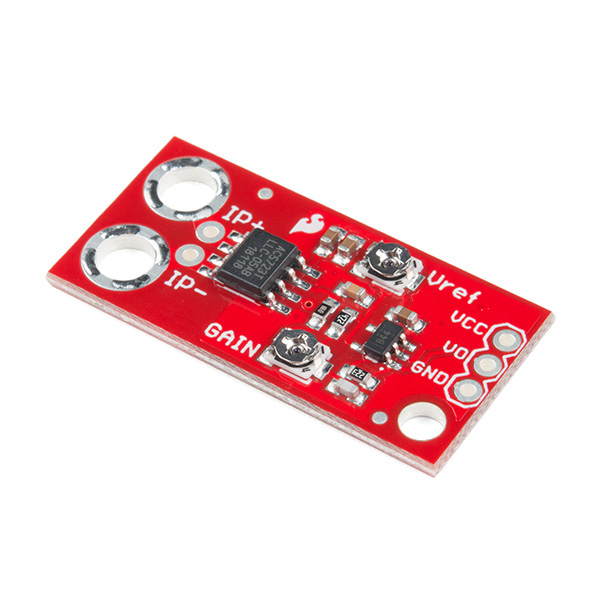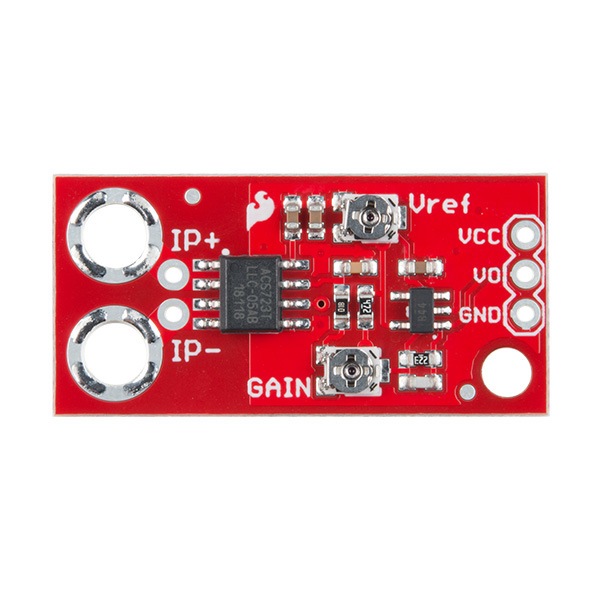SparkFun Current Sensor Breakout - ACS723 (Low Current)
The low current version of the SparkFun Current Sensor Breakout is a high accuracy board that utilizes the ACS723 for low to moderate AC and DC current sensing applications. The ACS723 sensor uses a Hall effect sensor to output a voltage relative to the current flowing through the IP+ and IP- pins on the board. The advantage of using a Hall effect sensor, specifically, is that the circuit being sensed and the circuit reading the sensor are electrically isolated meaning that, although your Arduino is running on 5V, the sensed circuit can be operating at higher DC or AC voltages!
This low current sensor breakout is capable of sensing very small currents down to around 10mA and large currents up to 5A! However, since the output is analog, your usable readings will be limited by noise and the resolution of the ADC reading the output. Additionally, this breakout has full electrical isolation of measured and sensed circuits and (thanks to an on-board amp) can adjust its sensitivity. Although the analog output is adjustable to 80kHz, the bandwidth on the ACS723 Sensor Breakout width filter has been set to 20kHz to reduce noise when using at high gains. The full 80KHz bandwidth that the sensor is capable of can be recovered by closing the JP1 (Bandwidth Select) jumper on the back of the board.
Note: Although the chip itself is rated for up to 2.4kV (RMS) of isolation, the board has not been designed for such high voltage applications.
- Schematic
- Eagle Files
- Hookup Guide
- Datasheet (ACS723)
- GitHub
SparkFun Current Sensor Breakout - ACS723 (Low Current) Product Help and Resources
Current Sensor Breakout (ACS723) Hookup Guide
June 21, 2018
Learn how to measure the current consumption of your project using the ACS723 Current Sensor.
0 of 1 found this helpful:
Board Dimensions
Width = 15.24mm/0.60"
Length = 31.75mm/1.25"
Core Skill: Soldering
This skill defines how difficult the soldering is on a particular product. It might be a couple simple solder joints, or require special reflow tools.
Skill Level: Noob - Some basic soldering is required, but it is limited to a just a few pins, basic through-hole soldering, and couple (if any) polarized components. A basic soldering iron is all you should need.
See all skill levels
Core Skill: DIY
Whether it's for assembling a kit, hacking an enclosure, or creating your own parts; the DIY skill is all about knowing how to use tools and the techniques associated with them.
Skill Level: Noob - Basic assembly is required. You may need to provide your own basic tools like a screwdriver, hammer or scissors. Power tools or custom parts are not required. Instructions will be included and easy to follow. Sewing may be required, but only with included patterns.
See all skill levels
Core Skill: Programming
If a board needs code or communicates somehow, you're going to need to know how to program or interface with it. The programming skill is all about communication and code.
Skill Level: Rookie - You will need a better fundamental understand of what code is, and how it works. You will be using beginner-level software and development tools like Arduino. You will be dealing directly with code, but numerous examples and libraries are available. Sensors or shields will communicate with serial or TTL.
See all skill levels
Core Skill: Electrical Prototyping
If it requires power, you need to know how much, what all the pins do, and how to hook it up. You may need to reference datasheets, schematics, and know the ins and outs of electronics.
Skill Level: Competent - You will be required to reference a datasheet or schematic to know how to use a component. Your knowledge of a datasheet will only require basic features like power requirements, pinouts, or communications type. Also, you may need a power supply that?s greater than 12V or more than 1A worth of current.
See all skill levels
Comments
Looking for answers to technical questions?
We welcome your comments and suggestions below. However, if you are looking for solutions to technical questions please see our Technical Assistance page.
Customer Reviews
3.5 out of 5
Based on 2 ratings:
5 of 7 found this helpful:
It's good for most hobbyists probably.
My issue with this current sensor board is that it has a resolution limited to about 200 values over the 0 - 1A range. The Vref and Gain knobs only multiply the raw data by a constant, but don't increase the resolution really.
I thought the knobs would allow me to achieve 1024 unique values across my desired usage range. They didn't do that though, so it didn't work out for my purposes.
It is still very good in my opinion. The data value fluctuates heavily but I used a first order filter to smooth that out. If you don't need high resolution this will work well for you.
I spent many hours trying to adjust Vref and Gain to get it optimized for my range.
Nicely made!
Well thought out, good layout and connection points. Only dings are Vref and Gain pots should be 10 turn for ease in making & keeping adjustments.





So this only has a resolution of about 10 mA? Is there anything that's more like 1 mA resolution, <1 A total?
What is recommended for projects where AnalogInput pin and VCC are 3.3V. Seems like ACS723 is specifically 5V only.
Would prefer to avoid level shifter
This board is not suitable for 120v or 240v as the ground pour under the chip is too close to the input side for proper isolation.